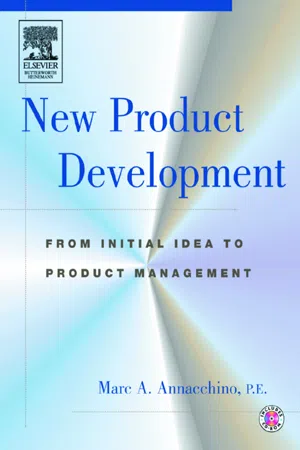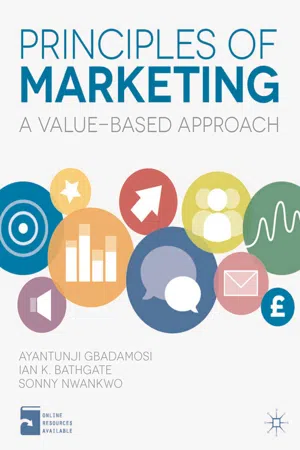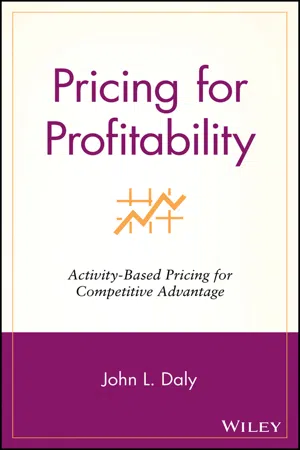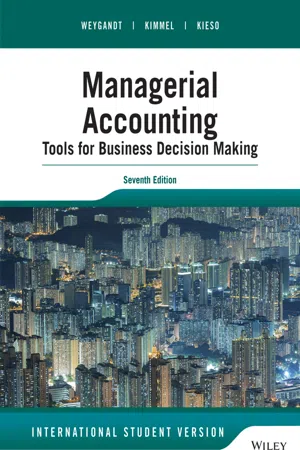Marketing
Cost Based Pricing
Cost-based pricing is a pricing strategy where the selling price of a product is determined by adding a markup to the cost of production. It involves calculating the total cost of producing a product, including both variable and fixed costs, and then adding a desired profit margin to set the selling price. This approach is commonly used by businesses to ensure they cover their costs and generate a profit.
Written by Perlego with AI-assistance
Related key terms
1 of 5
8 Key excerpts on "Cost Based Pricing"
- eBook - PDF
New Product Development
from Initial Idea to Product Management
- Marc Annacchino(Author)
- 2003(Publication Date)
- Butterworth-Heinemann(Publisher)
Understand where and why the motivation for the exchange of funds for product takes place; otherwise you may draw the incorrect conclusions from someone else’s history. The other caveat to remember, when being tempted to drive volume by cutting price, is that price is only one component of the transaction. It cannot be the sole driver of a buying decision in a vacuum of other factors. Since the buying decision is not a single-dimensional issue, the single dimension of price reduction cannot necessarily drive huge volume increases. Cost-Based Strategies The cost-based strategies consist of several approaches, as listed. They all ignore the demand side of the marketing equation and focus solely on internal needs. A. Formula pricing This is a strategy in which the cost elements or subcomponents are manipulated in a mathematical arrangement to generate a price large enough to absorb all other costs, transaction uncertainty, and provide for profit. It has pure internal focus and neglects market acceptance criteria. For example, if the product cost is $50 and the formula is a 3x multiple, the price is $150. Fifty dollars is the cost, and the balance of $100 is for other costs and profit. B. Cost plus The cost plus strategy is like a snowplow, in that it simply adds the required expense numbers and the required profit to the base cost to generate the price. This absorbs the uncertainty and provides for profit by decree. The premise is that the general level of consumption is stable, known, and understood. It also assumes that the market for the product is less sensitive to price. C. Cost plus by intermediaries This can be characterized by accumulating price as the product progresses through the sales channel. Each intermediary will get his or her “cut” on the way to the cus-tomer. The dynamics are channel dependent and involve “customary” markups. They can be different for different classes of product within the same sales channel. - eBook - PDF
- Michael Broadbent, John M. Cullen(Authors)
- 2014(Publication Date)
- Butterworth-Heinemann(Publisher)
Cost structure of the firm In Chapter 7, on short-term decision-making, we considered the concept of cost-volume-profit analysis, which presented the idea of a break-even level of activity. If a company has high fixed costs its break-even activity will be high relative to a company with low Pricing 245 fixed costs. Because a company must at least break even to survive, it is crucial that price, and hence contribution per unit are set so that break-even activity levels are reached. Product life cycle Within the marketing literature there is a concept of products having a finite life, and that over their life cycle, they go through different stages of development. The analysis used in this chapter will high-light four stages: 1 Introduction 2 Growth 3 Maturity 4 Saturation and decline Pricing policies and objectives may vary with the life cycle of the product, and this specific issue will be developed after the accountant's contribution to the pricing decision has been illustrated. Accountant's contribution to the pricing of products through Cost Based Pricing approaches The approaches put forward in this section relate to costing ideas developed in Chapters 4 and 7. If you need clarification of the terminology or methodology it may be useful quickly to revise these chapters. The three methods of Cost Based Pricing are: • Full cost pricing • Rate of return pricing • Marginal pricing Each is calculated using accounting data relating to the product cost, whether it be manufactured or within the service sector. The most widely used approaches are, full cost pricing and rate of return pricing, which are known collectively as cost-plus pricing. The 'plus' element is to add a figure to cost thus ensuring the firm is selling products at a price greater than cost. These two approaches are traditional and widespread. - eBook - PDF
Managerial Accounting
Tools for Business Decision-Making
- Jerry J. Weygandt, Paul D. Kimmel, Ibrahim M. Aly(Authors)
- 2020(Publication Date)
- Wiley(Publisher)
• Commonly, when a company sets a product price, it does so as a function of, or relative to, the cost of the product or service. This is referred to as total cost-plus pricing. • Under total cost-plus pricing, a company first determines a cost base and then adds a markup to the cost base to determine the target selling price. If the cost base includes all of the costs required to produce and sell the product, then the markup represents the desired profit. • The size of the markup (profit) depends on the return the company hopes to generate on the amount it has invested. • In determining the optimal markup, the company must consider competitive and market conditions, political and legal issues, and other relevant factors. • Once the company has determined its cost base and its desired markup, it can add the two together to determine the target selling price. The basic cost-plus pricing formula is expressed in Illustration 9.3 (see Decision Tools). Decision Tools The formula in Illustration 9.3 represents how managers use cost-plus pricing to achieve the desired profit. Solution The desired profit for this new product line is $250,000 ($1,000,000 × 25%). Each cover must result in $1.25 of profit ($250,000 ÷ 200,000 units). Market price − Desired profit = Target cost per unit $20 − $1.25 = $18.75 per unit Related exercise material: BE9.1, E9.16, E9.17, and DO IT! D9.12. Total Cost-Plus Pricing To illustrate, assume that Thinkmore Products Inc. is in the process of setting a selling price on its new video camera pen. It is a functioning pen that will record up to 2 hours of audio and video. The per-unit variable cost estimate for the video camera pen is shown in Illustration 9.4. - eBook - PDF
Principles of Marketing
A Value-Based Approach
- Ayantunji Gbadamosi, Ian Bathgate, Sonny Nwankwo(Authors)
- 2013(Publication Date)
- Bloomsbury Academic(Publisher)
(This is covered in detail elsewhere.) Cost consideration is very important because reducing cost is one of two ways a company can increase its profitability. The other is to increase price, which is not always possible. In this 212 pricing strategies section we look at the different types of costs that marketers must consider in their pricing decision. Fixed costs These are the costs associated with the production of products and services. These costs do not change in the short run as a result of changes in sales volume. For exam-ple, the annual depreciation on the manufacturing plant and salaries of full-time employees are considered as fixed costs. Other examples are rents, rates and loan interest payments. Variable costs This type of cost varies directly with the number of products and so changes in proportion to the sales volume. For example, the costs of running the plant, materials and power are variable costs. Marginal costs These are variable costs consisting of labour and material costs, plus an estimated portion of fixed costs (such as administration overheads and selling expenses). In companies where average costs are fairly constant, marginal cost is usually equal to average cost. However, in industries that require heavy capital investment (such as automobile plants, airlines and mines) and have high average costs, it is compara-tively very low. The concept of marginal cost is critically important in resource allocation because, for optimum results, management must concentrate its resources where the excess of marginal revenue over the marginal cost is maximal. Total costs These represent all the costs incurred by an organization in manufacturing, market-ing, administration and delivering the product to the customer. Total cost is the sum of fixed and variable costs. Research shows that companies consistently undercharge for products despite spending millions to develop or acquire such products. - eBook - PDF
- James Jiambalvo(Author)
- 2019(Publication Date)
- Wiley(Publisher)
This process is circu- lar for manufacturing firms in that the quantity demanded, which is needed to estimate full cost per unit, is determined prior to setting the price, which has a major impact on the quantity demanded. Using target costing, companies analyze the marketplace and decide on a set of features and a price point for their product. They subtract a desired profit level from the price to solve for the target cost. The product is then designed to meet the target cost when it is produced. If the target cost cannot be achieved, the company may reconsider the set of features and the price or decide not to go ahead with the product. LEARNING OBJECTIVE 3 Analyze customer profitability, and explain the activity-based pricing approach. The profitability of a customer depends not just on what is purchased but also on the set of services provided to the customer (e.g., order processing, shipping, handling returns, etc.). To analyze the profitabil- ity of a customer, the cost of such services must be subtracted from the customer’s gross margin. This requires that service costs must be grouped into cost pools and related cost drivers must be identified so that the cost per unit of service can be allocated to specific customers. In activity-based pricing, customers are presented with a menu of prices and are charged for services provided to them (in addition to being charged for the goods they purchase). The charge for such services usually is determined based on an analysis of their costs. Since they are charged for specific services, customers will carefully consider the services they request and may end up imposing less cost on suppliers. Review Problems Review Problem 1 Heartland Tools is a large Midwest company that designs and manufactures dies, jigs, fixtures, roll-form tooling, and special machines. Equipment used by the company includes mill- ing machines, HeliArc welders, drill presses, hydraulic presses, and heat treatment ovens. - eBook - PDF
Pricing for Profitability
Activity-Based Pricing for Competitive Advantage
- John L. Daly(Author)
- 2002(Publication Date)
- Wiley(Publisher)
When the common-sense techniques of activity-based costing were first described to me, our own techniques were far enough advanced that I could honestly say, “Oh yes, that is the costing method that we use.” I wrote my first article on the uses of ac- tivity-based costing for pricing in 1993, coining the term activity-based quoting for that article. I later concluded that activity-based pricing was a better descrip- tion for these techniques because all companies price their products, whereas only some businesses prepare actual quotes. Pricing for Profitability is designed to provide tools that will allow companies to consistently earn a real economic profit on the things that they sell. It is about the interrelationships of price and sales volume, and sales volume and cost. Other pricing books treat the relationship between price and cost lightly, as if cost were a minor consideration in pricing strategy. My own consulting experience has shown that too many companies unknowingly price their products at a loss, sometimes a substantial loss, because they have not understood these interrelationships. The objectives of activity-based pricing are as follows: • Establish price based on a solid knowledge of customer demand and prod- uct cost. • Never unintentionally price a product at a loss. • Know how much of price is profit. • Generate a superior financial return through superior financial knowledge. This book has been organized so that it can be read at several different levels of detail. There are 12 chapters. Chapter 1 provides an overview of the book and Chapter 12 provides a summary of all of the other chapters. The chapters in be- tween provide an in-depth look at 10 different topics followed by chapter summa- ries. Chapter 7, “Activity-Based Pricing,” gets to the heart of what the book is all about. A glossary of terms may be found in the back of the book. These terms are italicized in the text the first time that they appear. - eBook - PDF
Applied Marketing
Connecting Classrooms to Careers
- Daniel Padgett, Andrew Loos(Authors)
- 2019(Publication Date)
- Wiley(Publisher)
To be safe, marketers should not use comparison prices that cannot be justified via prior sales. Chapter Summary 10.1 The Price–Customer Cost Relationship • The price–customer cost relationship: Price is a measure of the relative value of an item for both the customer and the seller. • As the monetary commitment in the exchange from the custom- er’s side, price is the most objective assessment of the value of a product. • Price is judged against not only the monetary value of the prod- uct, but also nonmonetary costs. For the seller, price has to include not only the cost of making the product, but also a por- tion of all the other costs associated with being in business. • Setting a price that is acceptable to both the buyer and seller must be based on an understanding of customer cost and seller’s costs as well. FIGURE 10.8 Will the Dealer Ever Sell This Car at the MSRP? © B Christopher/Alamy Stock Photo 200 CHAPTER 10 Managing Price and Customer Cost Perceptions Key Concepts reference price variable costs fixed costs skimming pricing penetration pricing price elasticity elastic demand cost-based pricing value-based pricing prestige pricing static pricing dynamic pricing price lining price-fixing price discrimination predatory pricing bait and switch MSRP (Manufacturer’s Suggested Retail Price) 10.2 Influences on Price Setting • Influences on price setting: There are four primary factors that influence prices—customer perceptions or expectations, company costs, market characteristics, and competition. • Customers have expectations for price (called reference prices) that they use to judge value. • Company costs have to be covered, including variable costs (costs that vary with production and sales) and fixed costs (costs that do not vary with production and sales). Prices have to be based on both cost elements to be financially sound. - eBook - PDF
Managerial Accounting
Tools for Business Decision Making
- Jerry J. Weygandt, Paul D. Kimmel, Donald E. Kieso(Authors)
- 2015(Publication Date)
- Wiley(Publisher)
None of these approaches guar-antees a profit or a desired ROI. Achieving a desired ROI is the result of many factors, some of which are beyond the company’s control, such as market condi-tions, political and legal issues, customers’ tastes, and competitive actions. Because absorption-cost pricing includes allocated fixed costs, it does not make clear how the company’s costs will change as volume changes. To avoid blurring the effects of cost behavior on net income, some managers therefore prefer variable-cost pricing. The specific reasons for using variable-cost pricing, even though the basic accounting data are less accessible, are as follows. 1. Variable-cost pricing, being based on variable cost, is more consistent with cost-volume-profit analysis used by managers to measure the profit implica-tions of changes in price and volume. 2. Variable-cost pricing provides the type of data managers need for pricing special orders. It shows the incremental cost of accepting one more order. 3. Variable-cost pricing avoids arbitrary allocation of common fixed costs (such as executive salaries) to individual product lines. Variable Markup Variable Target Cost per Unit 1 Percentage 3 Cost per Unit 5 Selling Price $60 1 (175% 3 $60) 5 $165 _ _ Illustration 8A-8 Computation of target price— variable-cost pricing Using a target price of $165 will produce the desired 20% return on investment for Thinkmore on its video camera pen at a volume level of 10,000 units, as shown in Illustration 8A-9. The third step is to set the target selling price. Using a markup percentage of 175% and the contribution approach, Thinkmore computes the selling price as shown in Illustration 8A-8.
Index pages curate the most relevant extracts from our library of academic textbooks. They’ve been created using an in-house natural language model (NLM), each adding context and meaning to key research topics.







